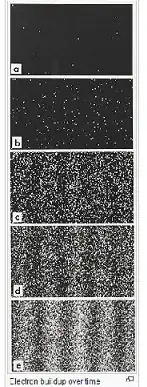According to standard quantum mechanics, after a measurement, the original state will "collapse" to one of the eigenstate of the observable, and if one measures it immediately after , the result will be the same. Does the second measurement give the same result in experiment? Is there any real experiment demonstrate this that the immediate measurement gives the same result, or this is just a theoretical assumption?
2 Answers
The depends upon whether the state evolves after the first measurement. Assume the state $$ |\psi\rangle~=~c_1(t)|1\rangle~+~c_2(t)|2\rangle. $$ where the amplitudes are given by a unitary operator. Assume we have the unitary operator $$ U(t)~=~e^{-iE_{11}t/\hbar}|1\rangle\langle 1|~+~e^{-iE_{22}t/\hbar}|2\rangle\langle 2|~+~(1~-~e^{-iE_{12}t/\hbar})|1\rangle\langle 2|~+~(1~-~e^{-iE_{21}t/\hbar})|2\rangle\langle 1|, $$ so the time evolution of the amplitudes are defined according to $c_1(0)$ and $c_2(0)$. Here the energies $E_{11}$ and $E_{22}$ are the eigenvalues and $E_{12}$ and $E_{21}$ define the transition from state $2$ to $1$ and $1$ to $2$ respectively.
Let us now consider the collapse of a wave function $|\psi\rangle~\rightarrow~|1\rangle$. I am ignoring issues of many worlds or decoherence and thinking in a very Copenhagenish manner. The state then evolves in a time $\delta t$. In this time period it many evolve into $$ |\psi(\delta t)\rangle~=~U(\delta t)|1\rangle~\simeq~\left[\left(1~-~\frac{iE_{11}\delta t}{\hbar}\right)|1\rangle\langle 1|~+~\frac{iE_{21}\delta t}{\hbar}|2 \rangle\langle 1|\right]|1\rangle $$ $$ =~\left(1~-~\frac{iE_{11}\delta t}{\hbar}\right)|1\rangle~+~\frac{iE_{21}\delta t}{\hbar}|2 \rangle. $$ There is then a bit of evolution back into the state $|2\rangle$. After time $\delta t$ the probability the state is in $|1\rangle$ is $1~-~({E_{11}\delta t}/{\hbar})^2$, which is nearly unity. So if we make another measurement we are most likely to find it in $|1\rangle$. There is some $\epsilon$ probability $({E_{21}\delta t}/{\hbar})^2$ it is in state $|2\rangle$.
This is the basis of the so called quantum Zeno effect. If a system is measured and reduced to a state then repeated measurements on time intervals much smaller than the periodicity of the system will force it to remain in that state.
- 13,005
There are a lot of misunderstandings here:
after a measurement,
One must define "measurement" . Meauserement gives a value from the real numbers from the quantum mechanical probability distribution which is confusingly named a "collapse". The probability distribution is the complex conjugate square of the wavefunction which is a solution of the appropriate quantum mechanical equations for the specific boundary conditions. It is not a balloon. To measure the probability distribution one has to sample many times with the same boundary conditions. Each measurement contributes to building up the distribution.
For example in the scattering problem of double slit with single electrons at the time:
A single electron in the first screen is an instance from the probability distribution for the boundary conditions of the problem, a "collapse" in your terminology. The accumulation with the exact conditions of more and more electrons accumulates the probability distribution which can be fitted with the wavefunction of the system.
the original state will "collapse" to one of the eigenstate of the observable,
Each electron track, if one measured its properties,(momentum, polarization) has a unique value from the probability distribution. When it hits the screen a new boundary condition problem is set up:" electron hitting screen and ionizing", so the momentum etc are lost in the second interaction/measurement.
and if one measures it immediately after ,
We measured it with the spot on the screen. We cannot repeat the experiment so
the result will be the same.
is wrong.
The electron gave energy/momentum to ionize atoms on the screen. It cannot be measured again. Only similar electrons can be set up and in this example each "collapses" to a different direction and it is not repeatable.
Is there any real experiment demonstrate this idea?(that the immediate measurement gives the same result) or this is just a theoritcal assumption?
According to my explanation above this does not make sense within the probabilistic nature of quantum mechanics.
- 236,935
